What Are a Tower Crane Operator’s Responsibilities?
What are the responsibilities of a tower crane operator during an overhead lift? This section of the ASME B30.3 Tower Cranes standard outlines everything a tower crane operator needs to do during an overhead lift.
Have you seen a tower crane used to help build a high-rise building, and want to know what it is like to be a tower crane operator?
A tower crane operator is responsible for making safe and successful overhead lifts. While those are the main goals of any overhead lift, there are many other tasks that a tower crane operator must perform in order to conduct their lifts safely and successfully, as defined by industry standards.
In this article, we’ll discuss what ASME lists as the responsibilities of a tower crane operator before, during, and after an overhead lift.
What is ASME B30.3-2019 Tower Cranes?
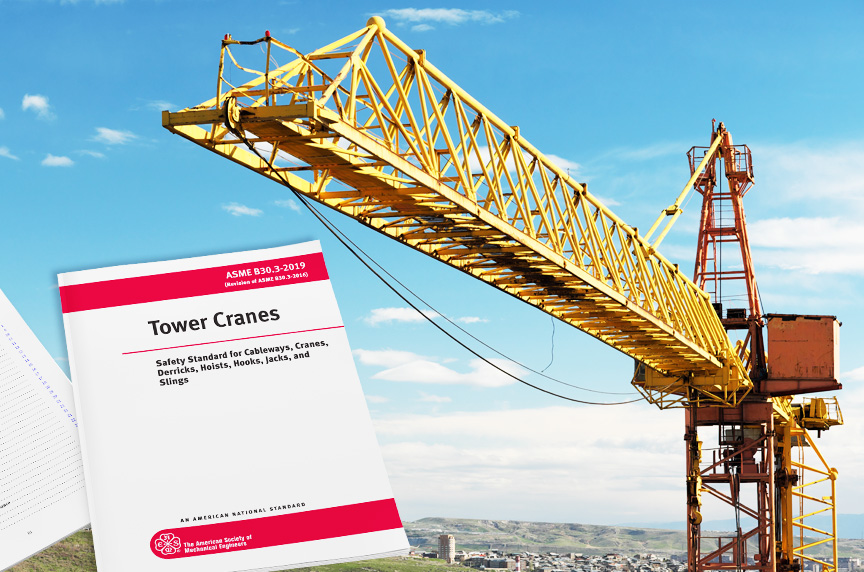
The mission of the American Society of Mechanical Engineers (ASME) is to set the standards for the lifting and rigging industry.
ASME is a professional association and leading international developer of codes and standards associated with the art, science, and practice of mechanical engineering. ASME members are engineers, scientists, government officials, and others who voluntarily contribute their technical expertise.
The first ASME B30.3 Tower Cranes standard was issued in 1996, Since then, this standard has been revised and published by the B30 Committee in 2004, 2009, 2012, 2016, and 2019.
The new ASME B30.3 Tower Cranes standard revises and supersedes the procedures outlined in the 2016 edition of the same standard.
According to the standard itself, ASME B30.3-2019 Tower Cranes applies to “construction tower cranes” and “permanently mounted tower cranes” that are powered by electric motors or internal combustion engines and that adjust their operating radius by means of a luffing boom mechanism, a trolley traversing a horizontal jib, or a combination of the two. The cranes may be mounted on “fixed bases” or “traveling bases” and may have tower and supporting structure arrangements that permit the crane to climb in a structure being built or that permits increasing the crane’s tower height as the structure rises.
“Variations of the above physical characteristics that provide the same fundamental operating characteristics are included in the scope of this Volume; however, the requirements of this Volume are only applicable to the cranes within this scope when they are used in lifting operations. Mobile cranes configured with tower attachments (refer to ASME B30.5) and self-erecting tower cranes (refer to ASME B30.29) are not within the scope of this Volume.”
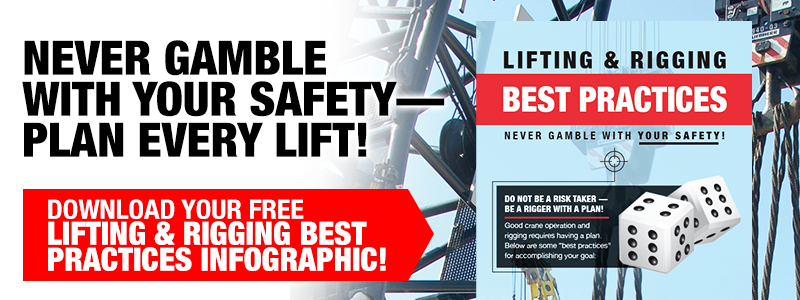
Who Can Operate a Tower Crane?
Cranes shall be operated only by the following qualified personnel:
- Designated persons
- Trainees shall be under the supervision of a designated person. The number of trainees permitted to be supervised by a single designated person, the physical location of the designated person while supervising, and the type of communication required between the designated person and the trainee shall be determined by a qualified person
- Maintenance and test personnel, when it is necessary in the performance of their duties
- Inspectors (crane)
According to the standard, “No one, other than personnel specified above, shall enter a crane cab, with the exception of persons such as oilers, supervisors, and those specific persons authorized by supervisors whose duties require them to do so, and then only in the performance of their duties and with the knowledge of the operator or other appointed person.”
What Qualifications Are Required to Operate a Tower Crane?
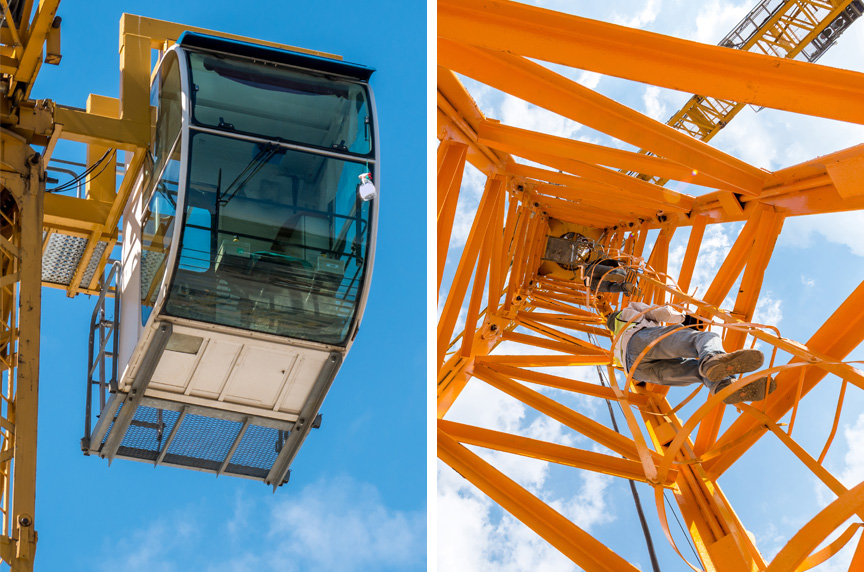
Operators shall be required to successfully meet the qualifications for the specific type of crane that they are operating:
- Operator and operator trainees shall meet the following physical qualifications unless it can be shown that failure to meet the qualifications will not affect the operation of the crane. In such cases, specialized clinical or medical judgments and tests may be required.
- Vision of at least 20/30 Snellen in one eye and 20/50 in the other, with or without corrective lenses.
- Ability to distinguish colors, regardless of position, if color differentiation is required.
- Adequate hearing to meet operational demands, with or without hearing aid.
- Sufficient strength, endurance, agility, coordination, and speed of reaction to meet the operation demands.
- Depth perception, field of vision, reaction time, manual dexterity, coordination, and no tendencies to dizziness or similar undesirable characteristics to meet the operational demands.
- A negative result for a substance abuse test. The level of testing will be determined by the standard practice for the industry where the crane is employed and this test shall be confirmed by a recognized laboratory service.
- No evidence of having physical defects or emotional instability that could render a hazard to the operator or others, or that in the opinion of the medical authority could interfere with the operator’s performance. If evidence of this nature is found, it may be sufficient cause for disqualification.
- No evidence of being subject to seizures or loss of physical control that cannot be controlled with medication; such evidence shall be sufficient reason for disqualification. Specialized medical tests may be required to determine these conditions.
- Operator requirements shall include, but not be limited to, the following:
- Evidence of successfully passing a physical examination as defined in (a)* above.
- Satisfactory completion of a written examination covering operational characteristics, controls, and emergency control skills, such as response to fire, power line contact, or control malfunction, as well as characteristic and performance questions appropriate to the crane types defined in para. 3-0.2.1** for which qualification is being sought. Type of crane means a crane with any combination of the applicable characteristics from each of the four group types defined in para. 3-0.2.1.
- Demonstrated ability to read, write, and comprehend the crane manufacturer’s documentation.
- Satisfactory completion of a combination written and verbal test on load/capacity chart usage skills that covers a selection of the configurations (the crane may be equipped to handle) for the crane type for which qualification is being sought.
- Satisfactory completion of an operation test demonstrating proficiency in performing lifting, lowering, trolleying or luffing, swinging, and travel (when so equipped) functions at various radii as well as taking the crane out of service. Testing shall also include proficiency in prestart and post-start inspection, and securing procedures by appropriate written, oral, or practical methods.
- Demonstrated understanding of the applicable Sections of the B30.3 Standard and applicable regulatory requirements.
- Operators who have successfully qualified for a specific crane type shall be required to be requalified every five years or sooner if supervision deems it necessary.
- Trainee qualification requirements shall include, but not be limited to, the requirements listed in the standard.
- Trainee qualification, operator qualification, and operator requalification shall be performed by a qualified person.
- Operator physical examinations shall be required every three years, or more frequently if site supervision deems it necessary.
*The paragraph cited in this section refers to physical requirements to operate a tower crane.
**This section refers to the definitions of crane types.
How Shall Tower Crane Operators Conduct Themselves?
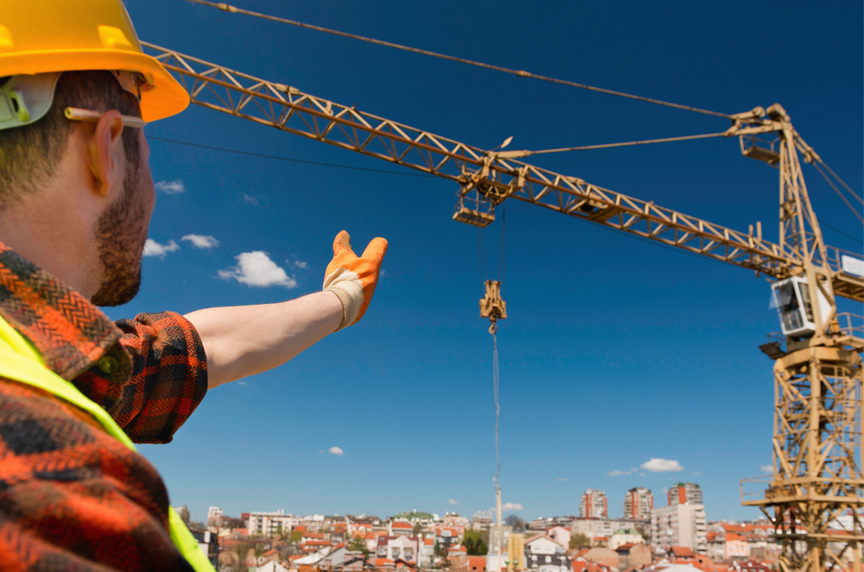
Section 3-3.1.3 outlines the following conduct required of operators:
- The operator shall not engage in any practice that might divert attention while actually engaged in operating the crane.
- When physically or mentally unfit, an operator shall not engage in the operation of the equipment.
- The operator shall respond to signals from the lift director or an appointed signalperson. When a signalperson is not required as part of the crane operation, the operator is then responsible for the lifts. However, the operator shall obey a stop signal at all times, no matter who gives it.
- Each operator shall be responsible for those operations under the operator’s direct control. Whenever there is any doubt as to safety, the operator shall consult with the supervisor before handling the loads.
- Before leaving the crane unattended, the operator shall:
- Land any load, bucket, lifting magnet, or other device.
- Set trolley brakes and other locking devices and bring the hook to the highest position.
- Disconnect power or disengage the master clutch, as applicable.
- Place all controls in the off or neutral position.
- Secure the crane against inadvertent travel.
- Stop the internal combustion engine, when provided. An exception may exist when crane operation is frequently interrupted during a shift. Under these circumstances, the crane may remain running while the operator remains on the crane superstructure.
- Leave the superstructure free to weathervane unless provisions for nonweathervaning have been specified by the manufacturer or by a qualified person.
- Restrain the crane from travel with rail clamps, or other means provided, when a wind alarm is given or on leaving the crane overnight.
- If there is a warning sign on the power-disconnecting means or starting controls, the operator shall not close the circuit or start the equipment until the warning sign has been removed by an appointed person.
- Before closing the power-disconnecting means or starting the equipment, the operator shall see that all controls are in the off or neutral position and that all personnel are in the clear.
- If power fails during operation, the operator shall:
- Set trolley, hoist, and travel brakes and locking devices, as applicable
- Move all clutch or other power controls to the off or neutral position
- Land the suspended load under brake control, if practical
- The operator shall be familiar with the equipment and its proper care. If adjustments or repairs are necessary, the operator shall report the condition promptly to the appointed person and shall also notify the next operator.
- All controls shall be tested by the operator at the start of a new shift. If any controls do not operate properly, they shall be adjusted or repaired before operations are begun.
- Cranes shall not be operated when wind speeds exceed the maximum velocity recommended by the manufacturer.
- Prior to daily operation, operator aids shall be checked to determine if they are working per para. 3-2.1.3(e)*.
- Operations undertaken during weather conditions that produce icing of the crane structure or reduced visibility should be performed at reduced function speeds and with signaling means appropriate to the situation.
*This paragraph outlines the requirements for a frequent inspection of a tower crane’s “indicating devices for load, radius, luffing boom angle, and wind velocity.”
What Are a Tower Crane Operator’s Responsibilities?
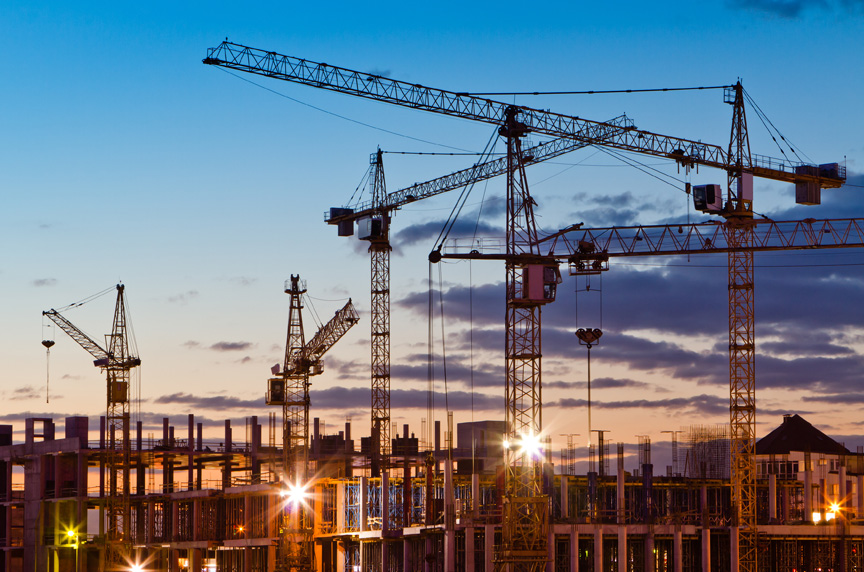
According to the standard, Operator responsibilities shall include:
- Reviewing the requirements for the crane with the lift director before operations.
- Knowing what types of site conditions could adversely affect the operation of the crane and consulting with the lift director concerning the possible presence of these conditions.
- Understanding and applying the information contained in the crane manufacturer’s operating manual.
- Understanding the crane’s functions and limitations, as well as its particular operating characteristics.
- Using the crane’s load rating chart and diagrams, and applying all notes and warnings related to the charts, to confirm the correct crane configuration to suit the load, site, and lift conditions.
- Refusing to operate the crane when any portion of the load or crane would enter the danger zone of energized power lines except as defined in para. 3-3.4.3*.
- Performing frequent inspections as specified in para. 3-2.1.3**.
- Promptly reporting the need for any adjustments or repairs to a designated person.
- Following applicable lock-out/tag-out procedures as determined by a qualified person.
- Not operating the crane when physically or mentally unfit.
- Ensuring that all controls are in the off or neutral position and that all personnel on the crane are in the clear before energizing the crane or starting the engine.
- Not engaging in any practice that will divert his/her attention while actually operating the crane controls.
- Testing the crane function controls that will be used and then operating the crane only if those function controls respond properly.
- Operating the crane’s functions, under normal operating conditions, in a smooth and controlled manner.
- Knowing and following the procedures specified by the manufacturer or approved by a qualified person, for erection, climbing, and dismantling.
- Ensuring that the load and rigging weight have been provided by the lift director.
- Calculating or determining the net capacity for all configurations that will be used and verifying, using the load rating chart, that the crane has sufficient net capacity for the proposed lift.
- Considering all factors known that might affect the crane capacity and informing the lift director of the need to make appropriate adjustments.
- Knowing the standard and special signals as specified in Section 3-3.3*** and responding to such signals from the appointed signalperson. When the signalperson is not required as part of the lift operation, the operator is then responsible for the movement of the crane. However, the operator shall obey a stop signal at all times, no matter who gives it.
- Understanding basic load rigging procedures and the provisions of para. 3-3.2.1(c)(1)****.
- If power fails during operations, the following shall apply:
- Setting all brakes and locking devices
- Moving all clutches or other power controls to the off or neutral position
- Landing any load suspended below the hook under brake control if practical
- Before leaving the crane unattended, the following shall apply:
- Landing any load suspended below the hook.
- Bringing the load block to the highest position.
- Moving controls to the off or neutral position.
- Setting brakes and other locking devices.
- Releasing of the slewing brake, unless provisions for nonweathervaning have been specified by the manufacturer or a qualified person.
- Restraining the crane from travel, if applicable, with rail clamps or other means provided.
- Disengaging the main control circuit or stopping the engine. An exception to this may exist when crane operation is frequently interrupted during a shift and the operator must leave the control station. Under these circumstances, the engine may remain running or the main control circuit energized and (1) through (3) above shall apply*****.
*This paragraph outlines crane operation in the vicinity of electric power lines.
**The referenced paragraph outlines the requirements for a frequent inspection of a tower crane.
***This paragraph references the types of standard and special signals needed to operate a tower crane.
****The referenced paragraph outlines how to attach a load to the tower crane.
*****Topics 1-3 are landing any load suspended below the hook, bringing the load block to the highest position, and moving controls to off or neutral positions.
What Can Mazzella Do to Help You Stay in Compliance with the ASME B30.3 Tower Cranes Standard?
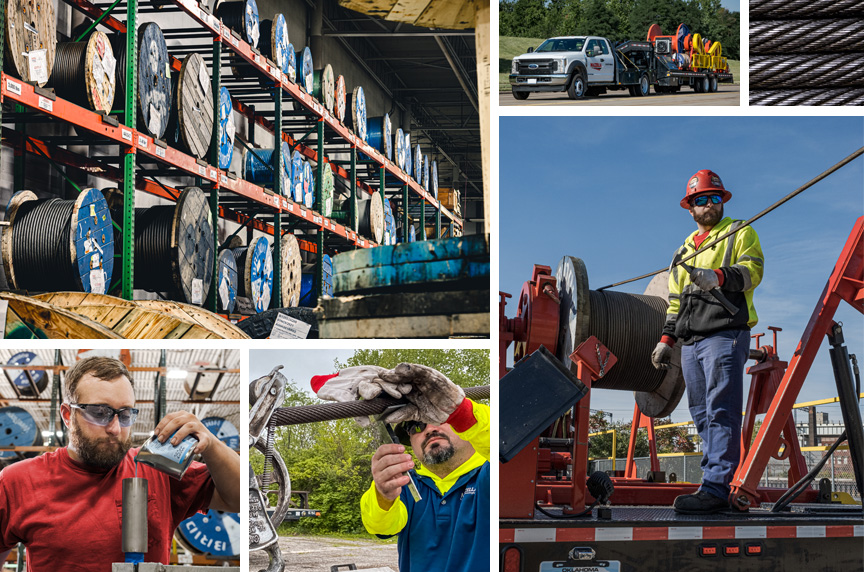
Mazzella is a one-stop-shop for high-performance crane ropes, or any kind of specialty ropes. Also, we have fittings and sockets that can be installed in the field, and a large inventory of ropes in stock that allows us to help get you back up and running as quickly as possible. Mazzella offers rope replacements, too.
Mazzella has one of the largest specialty rope inventories in the United States…ready for immediate delivery! We provide wire rope assemblies, and manufacture bridge cables, crane cables, steel mill cables, and thousands of OEM assemblies:
- In sizes from ¼” to 3” diameter and 9mm to 52mm diameter
- Domestic and Non-Domestic
- In stock and ready for same or next-day shipment from one of our many service centers
In addition to crane ropes installations and inspections, Mazzella has the capabilities to do button and OEM socket installations. We have technicians around the country who have been trained to do:
- Socket installs
- Perform crane rope inspections
Call us at 800.362.4601 or click here if you need wire rope products or assemblies.
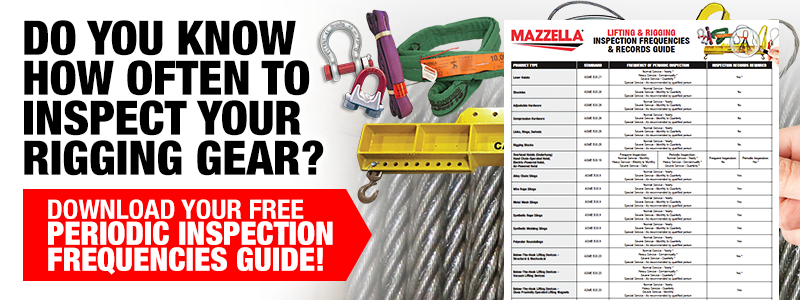

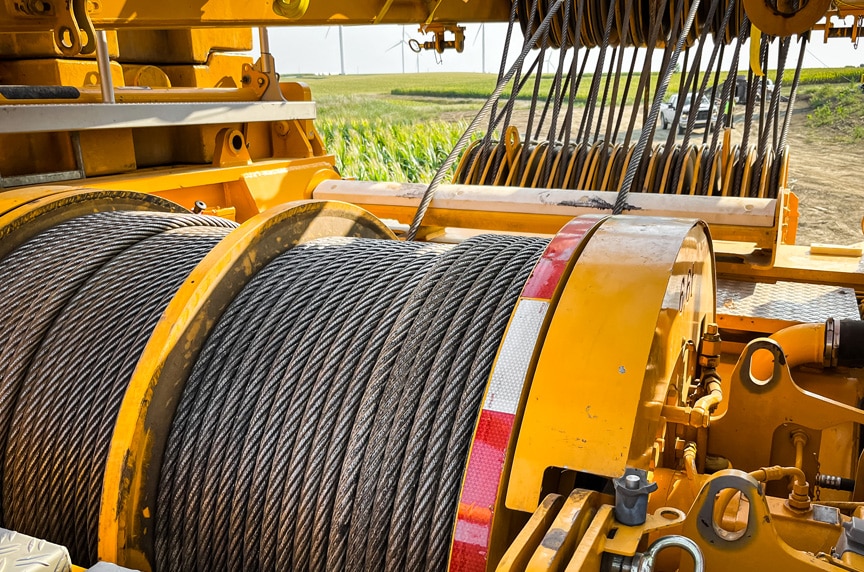
Crane Ropes
One Brand of Rope Will Not Work on Every Machine!
Mazzella stocks a large inventory of high-performance wire ropes available for immediate delivery.
Copyright 2023. Mazzella Companies.
